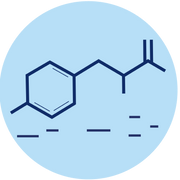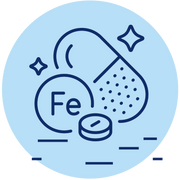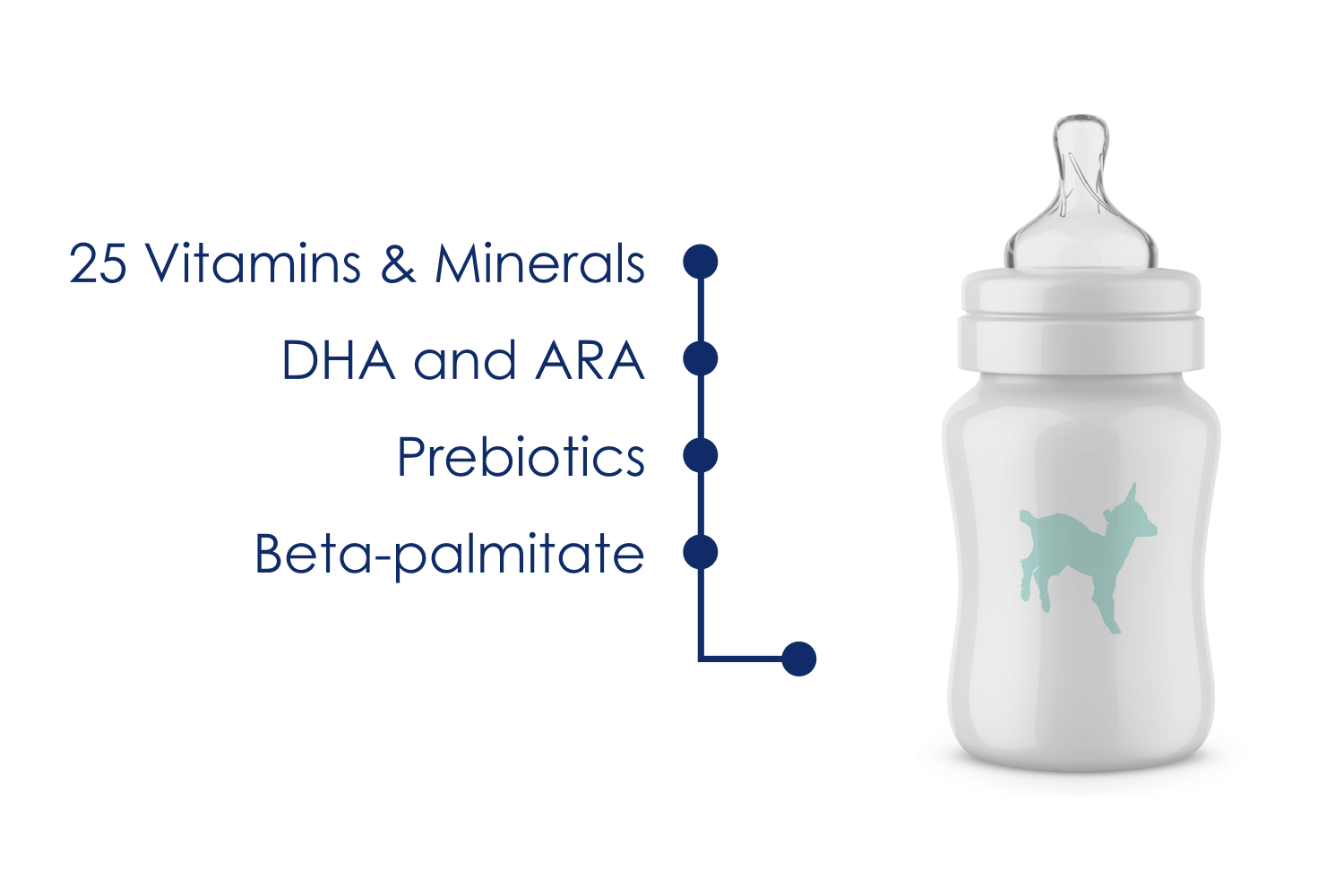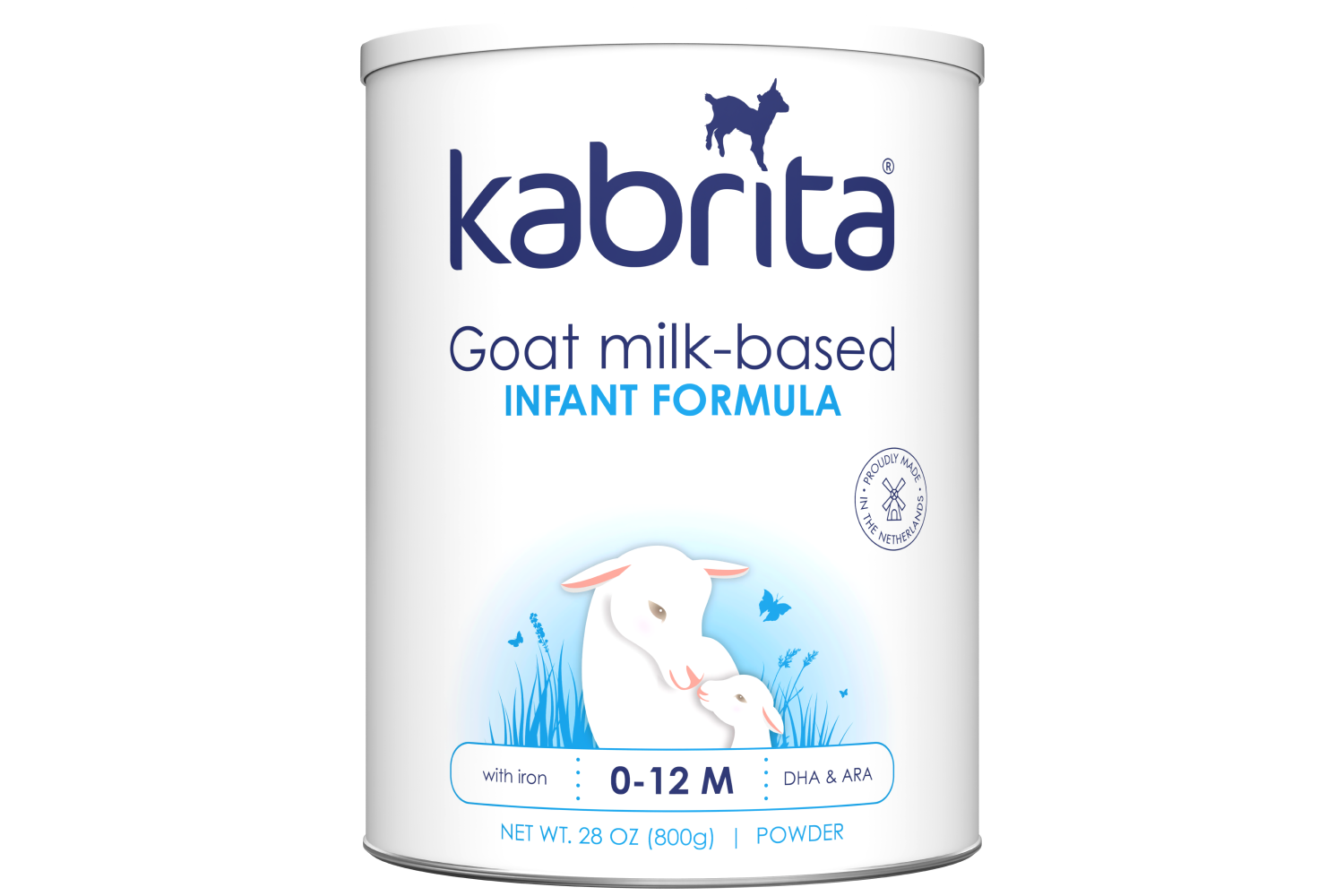-
Protein
-
Fat
-
Carbohydrate Source
-
Premium Fat Blend
-
Whey-to-Casein Ratio
-
DHA and ARA
-
Iron
Protein
Babies need protein to grow and stay healthy. It helps build and repair their body tissues, muscles, and organs.
Kabrita's formula made from goat milk has whey and casein proteins just like breast milk does. It's specially made with 60% whey and 40% casein, similar to the healthy ratio found in breast milk.
Plus our formula is gentle on little stomachs. As goat milk-based proteins break down, they form tiny, soft curds, unlike the harder ones from cow milk proteins, making it easier to digest.¹⁻²

Fat
Babies need fat for healthy brain and nervous system development and to support absorption of fat soluble vitamins.
Our formula is made with a unique blend of fats chosen for their high quality and based on the latest research in infant growth and development. It includes beta-palmitate (sometimes referred to as high2-palmitic acid), a type of fat that's found in breast milk.³
We also add DHA and ARA, two crucial omega fatty acids that babies normally get from breast milk, to our formula.

Carbohydrate Source
Babies grow fast and need lots of energy, which they get from carbohydrates.
Our formula gets most of its carbohydrates from lactose, the same natural carbohydrate source babies get from breast milk. We also add a little extra lactose to help with gentle digestion. Goat milk is also rich in a special kind of nutrient called oligosaccharides that act as a prebiotic and further helps babies digest comfortably.⁴
Lactose is the best carbohydrate for healthy babies because it's like breast milk, and that's why our formula does not add ingredients like corn syrup.

Premium Fat Blend
Beta-palmitate is a healthy fatty acid found in breast milk that is structurally different than those in vegetable oil. It helps babies absorb more calcium and fat and improves stool consistency. These benefits contribute to stronger bones, healthier guts, less crying, and better sleep for babies.
Kabrita is the only baby formula in the US with this special ingredient.⁵⁻⁷

Whey-to-Casein Ratio
Our formula is designed to be easy on baby's tummies. Our blend of whey and casein proteins is similar to what's in breast milk. The balance is 60% whey to 40% casein, which is easier for digestion.⁸⁻⁹

DHA and ARA
DHA and ARA are important omega 3 and 6 fatty acids that are found in breast milk. Our formula includes these fatty acids to support your baby's growth, especially brain and vision development.¹⁰⁻¹³

Iron
Iron helps make blood cells that carry oxygen around the body, and it's key for turning food into energy. Since not all babies get enough iron, the American Academy of Pediatrics suggests feeding with an iron-fortified formula, if they're not being exclusively breastfed, from birth up to their first birthday.¹⁴


Trust Kabrita Goat-Milk Based Infant Formula to provide the important ingredients babies need in a way that is closer to breast milk than cow milk-based infant formula is.
Our infant formula delivers gentle nutrition for growing babies and quality ingredients for parents who want to feel confident about their choice of infant formula.

The natural goodness of Dutch goat milk
Kabrita Goat Milk-Based Infant Formula is made with natural goat milk from the Netherlands, the dairy center of the world, where strict European standards limit the use of antibiotics and growth hormones.
All milk is supplied from over 100 Dutch family-run goat farms that comply with the Dutch Goat Dairy Organization animal welfare and food safety assurance program.
- No GMO ingredients
- No corn syrup
- No glyphosate

Ingredients: Lactose, non-fat dry goat milk, vegetable oils (soybean oil, high oleic sunflower oil, coconut oil), goat whey protein concentrate powder, high 2-palmitic acid, vegetable oil (palm oil), glucose syrup solids, galacto-oligosaccharides, and less than 1%: mortierella alpina oil, tri calcium phosphate, crypthecodinium cohnii oil, tri sodium citrate, choline bitartrate, calcium carbonate, potassium hydroxide, sodium L-ascorbate, choline chloride, taurine, inositol, magnesium carbonate, L-ascorbic acid, vitamin E acetate, ferrous sulfate, niacinamide, zinc sulphate, L-carnitine L-tartrate, calcium panthothenate, retinyl acetate, thiamin hydrochloride, riboflavin, manganese sulphate, cupric sulfate, pyridoxine hydrochloride, folic acid, vitamin K1, potassium iodide, D-biotin, sodium selenate, vitamin D3 and cyanocobalamin. Contains: Milk.
References:
1. Clark S, Mora Garcia MB. A 100-Year Review: Advances in goat milk research. J Dairy Sci. 2017;100(12):10026-10044.
2. Jakobsson I, Lindberg T. Cow's milk proteins cause infantile colic in breast-fed infants: a double blind crossover study. Pediatrics. 1983;71(2):268-271.
3. Innis SM. Dietary triacylglycerol structure and its role in infant nutrition. Adv Nutr. 2011;2(3):275-283.
4. van Leeuwen SS, et al. Goat milk oligosaccharides: their diversity, quantity, and functional properties in comparison to human milk oligosaccharides. J Agric Food Chem. 2020;68(47):13469-134865.
5. Bronsky J, et al. Palm oil and beta-palmitate in infant formula: a position paper by the European Society for Paediatric Gastroenterology, Hepatology, and Nutrition (ESPGHAN) Committee on Nutrition. J Pediatr Gastroenterol Nutr. 2019;68(5):742-760.
6. Havlicekova Z, et al. Beta-palmitate - a natural component of human milk in supplemental milk formulas. Nutr J. 2016;15:28.
7. Miles EA, Calder PC. The influence of the position of palmitate in infant formula triacylglycerols on health outcomes. Nutr Res. 210;44:1-8.
8. Nilsen H, Olsen HG, Hayes B, et al. Casein haplotypes and their association with milk production traits in Norwegian red cattle. Genet Sel Evol. 2009;41(1):24.
9. Lönnerdal B. Bioactive Proteins in Human Milk: Health, Nutrition and Implications for Infant Formulas. J Pediatr. 2016;173 Suppl:S4-S9.
10. Brenna JT. Arachidonic acid needed in infant formula when docosahexaenoic acid is present. Nutr Rev. 2016;74(5):329-336.
11. Lawrence RA, Lawrence RM. Breastfeeding: a guide for the medical profession. 2011: Elsevier Health Sciences.
12. McNamara RK, Able J, Jandacek R, et al. Docosahexaenoic acid supplementation increases prefrontal cortex activation during sustained attention in healthy boys: a placebo controlled, dose ranging, functional magnetic resonance imaging study. Am J Clin Nutr. 2010;91(4):1060-1067.
13. EFSA Panel on Dietetic Products, N.a.A.N. Scientific opinion on the substantiation of a health claim related to DHA and contribution to normal brain development pursuant to article 14 of Regulation (EC) No 1942/20061. EFSA J. 2009;12(10).
14. Fuchs G, Abrams S. Choosing a baby formula. Accessed October 27, 2023. https://www.healthychildren.org/Engligh/ages-stages/baby/formula-feeding/Pages/choosing-an-infant-formula.aspx

